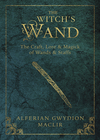An Interview with Alferian Gwydion MacLir
1. Your new book is titled, The Witch's Wand; it explores the creation of wands, and also includes tidbits of wand lore and personal stories from Witches in the community. Why are wands important to spellcraft and ritual?
Wands are important because they are the instrument of the magical will, and the projection and shaping of the Cosmos with one's will is the very root of magic. One may use other tools for specific ritual purposes, but the wand is basic to all magic. It is for pointing, directing the spirit of the mage, and for transformation, the power of fire. You can see from the little pieces in the book called "Wanderings" that each individual finds their own special relationship to their wands.
2. Your previous book, Wandlore, also focused on the art of making wands, and you are also a master wandmaker. How do you get started with wandmaking? From where do you draw inspiration for your woodwork?
I started by really being called by the trees. In my druid order—the Order of Bards, Ovates, and Druids—one works through lessons in three grades. The Ovate grade is the middle one and deals with all those aspects of magery that are often put together under the name of witchcraft. Divination, and work with Ancestors, animals, the Otherworlds, and trees are all parts of Ovate work. So, when I began studying trees and tree energy, along with the Bardic oghams, trees began to speak to me. I began to find branches and sticks dropped in my path and collected them. My first wand was made for myself and it is still the wand I used to enchant most of the wands I make.
As for inspiration, I derive ideas and motifs from all over but the inspiration comes from the trees themselves. When I work on a branch to make it a wand of magic, the dryad spirit of that branch directs me; it is entirely intuitive and mostly non-rational. Clients often tell me what specifics they want in a bespoke wand, but otherwise, I ask the branch where it wants to be cut, how it wants to be shaped, and what stones or crystals it may want.
3. The book includes information on both crafting our own wands as well as buying them. You obviously prefer the art of crafting one's own wand, but is there anything wrong with buying one?
Not at all; that is why I make them for others. It is fine to make a wand yourself, but it is not necessarily "better" because much depends on your attitude toward the wand. Having a wand crafted for you, or seeing one in a shop that calls to you, is just as good. It is important to love your wand, and if you start out feeling you are no good at woodworking, then you may be dissatisfied with what you make for yourself. In either case, the important part comes in your bonding with the wand and dedicating it to your own work.
4. The Witch's Wand also includes a vast number of wand spells and rituals, from a protection ritual to a spell to draw blessings to your family. Are these spells and rituals you use on a regular basis?
Of course! The examples I give in The Witch's Wand are just a few to show different ways a wand can be used. So many people ask me: how do you use a wand? In this book, I really wanted to answer that question. Seasonal attunement is a continuous druid practice all year round, which is also practiced by most Pagans, witches, and other nature religions. Spells for protection and success in one's work; spells for finding lost objects; or for attracting inspiration, relationships, or information that is desired—these are the most common and practical kinds of magic. Occasionally, young aspiring wizards ask me if they can make fireballs with a wand, and I respond to that question with advice against it. What legitimate purpose would making fireballs serve, outside of a game of Dungeons and Dragons? It is just as dangerous as picking up a flame-thrower. Why not learn a spell that will make a cake bake perfectly or keep a soufflé from falling? Much more useful.
5. What do you hope your readers will take away from The Witch's Wand?
I hope they will derive pleasure from learning and will try the techniques I suggest in their own magical practice. One hopes the book will help them choose a wand or a branch to use to craft their own wand. For me, there are few better joys and using one of my wands to bring something good into manifestation. It is a delicate art, like any other, and there is great satisfaction to do it well and for a spell to work perfectly. If the reader is a novice to magery, then I hope she or he will pursue the Craft and seek further wisdom from a way of life that approaches the world as a creative process. A witch or mage does not see the world as an "outer" phenomenon over which she has not control; she sees inner and outer as illusory categories, and once that illusion is overcome, self and world become creative partners in the Great Work of transformation. Maybe that's a bit much to expect from reading my book, but if it plants a seed, that is good enough.

